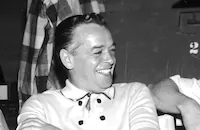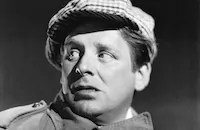Directed by Joseph Pevney and produced by Leonard Goldstein, Flesh and Fury (1952) stars Tony Curtis as a deaf boxer who triumphs in the ring and finds himself in a romantic love triangle with Jan Sterling and Mona Freeman. Hollywood kept going back to the well for stories from the boxing world. It proved to be quality fodder for movies about the human condition, crime and inequality replete with action sequences that kept audiences entertained. UniversalInternational Pictures had been grooming a stable of young talent to add fresh new faces to their roster. (Rock Hudson had recently starred in the boxing film Iron Man (1951), also directed by Pevney.) Actor turned producer William Alland came up with a new story perfect for showcasing another young actor, this time Tony Curtis. It’s very likely that Alland was inspired by Eugene Hairston, who went by the moniker Silent Hairston, a deaf-mute African-American boxer in the middleweight category who was active during the late 1940s and the early 1950s.
Curtis had signed with Universal-International in 1949 and made a splash with his debut in the film noir Criss Cross (1949). With crew cuts all the rage, Curtis stood out with his voluminous dark curls which earned him the nickname “the kid with the haircut.” That, along with his on-screen charisma, his piercing gaze and athletic build, made him popular among bobbysoxers. Universal had been grooming Curtis for stardom with voice lessons to soften his thick New York accent and acting lessons to prepare him for leading man roles. Curtis landed his first big-budget film in the Jimmy Stewart Western Winchester ’73 (1950) and his first leading role in the swashbuckling drama The Prince Who Was a Thief (1951). Flesh and Fury gave him an opportunity to flex his acting muscles and take on a more serious role.
Originally titled Hear No Evil, Flesh and Fury was written by newcomer Bernard Gordon, who had worked as a script reader and assistant story editor at Paramount. He helped found the Screen Readers Guild, was a member of the Communist Party and was connected with other leftists in the industry. Fellow script reader Alfred Levitt introduced Gordon to his friend William Alland at Universal. Alland invited Gordon, who had never written a screenplay before, to work on a pirate drama at Universal. According to Gordon’s memoir, when that project fell through, “luck was with me. Bill Alland arranged for me to be transferred to another project, one for which he had created the story. He liked my work well enough to want me to write it.” With the support of Alland, studio executive Leonard Goldstein and Tony Curtis, who according to Gordon “couldn’t wait to get the first real script into his hands,” Gordon wrote his first screenplay which was immediately put into production upon completion. Alland was so pleased with Gordon that instead of letting him go as soon as he was no longer needed, he took Gordon under his wing and assigned him the role of screenwriter for The Lawless Breed (1952). However, Gordon had the bad luck of launching his screenwriting career during a highly tumultuous time in the industry. The House Committee on Un-American Activities was investigating communist activity in Hollywood. Gordon was never called to testify, but Alland was and he named Gordon, among others, as communists. Gordon was consequently blacklisted but continued to work under the pseudonym Raymond T. Marcus.
Production for Flesh and Fury took place on the Universal studio lot from October 19th until November 21st, 1951. Starring opposite Curtis was Jan Sterling who played Sonya, the sultry blonde gold-digger, and model-turned-actress Mona Freeman as the empathetic journalist. Both actresses were playing to their strengths. Sterling was at the height of her career in the 1950s playing hard-boiled dames and saucy, outspoken women. Freeman, on the other hand, saw her career peak in the late 1940s during her teenage years. Now as an adult, her career was slowing down and she was mostly cast in B-movie programmers and in demure roles. A New York Times review noted that Universal had “upholstered” the film “with a trim little cast” of character actors. These included Wallace Ford as Curtis’ manager, as well as freelancers like Harry Guardino, Nella Walker, Louis Jean Heydt and Tom Powers.
Much care was put into giving the boxing scenes a sense of authenticity. Prize fighter and referee Frankie Van was hired as a technical advisor on the film and had a bit role in the film. Van established a long career in the industry advising, training and acting in numerous boxing films from the late 1930s all the way up until the 1970s with films like Ex-Champ (1939), The Ring (1952), The Square Jungle (1955) and Rocky (1976). Joe Gray, former boxing champ, also found a new career in the business as an actor, stuntman and fight coordinator. He plays Cliff, Curtis’ training partner, and it’s very likely he trained Curtis for the fight sequences. Curtis was naturally athletic but had no formal experience as a boxer and during rehearsals broke his thumb. Pevney arranged for all fighting sequences to be filmed last to give Curtis time to recover. Other boxers in the film include former welterweights Jack Perry and Tommy Herman and lightweight Rito Punay.
Flesh and Fury had its world premiere in New Orleans on March 12th, 1952 with a New York City opening two weeks later. In the fall of ’52, the film was distributed internationally throughout East Asia, Europe, South America, Northern Africa and the Middle East. Flesh and Fury received mixed reviews that leaned towards the positive. Most outlets praised Tony Curtis’s talents as a dramatic male lead as well as a convincing boxer. The Hollywood Reporter called the film “a rousing action-filled drama of the prize ring. Flesh and Fury offers a novel twist that lifts it out of the realm of ordinary fight pictures.” Flesh and Fury remains as an obscure entry in the boxing film subgenre.
by Raquel Stecher





























